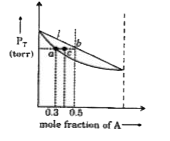The osmotic pressure of a solution containing 0.10g of haemoglobin in 10 cm of solution is 30 Torr at 300 K. The molar mass of haemoglobin is nearlySolution in Malayalam
4500 g mol−1
5452 g mol−1
6232 g mol−1
6932 g mol−1
The correct Answer is:C
M2=(m2V)(RTπ)=[0.10g10.0×10−3L]⎡⎢
⎢⎣(0.082 L atm K−1mol−1)(300K)(30/760)atm⎤⎥
⎥⎦
=8.2×760gmol−1=6232 g mol−1
Topper's Solved these Questions
- BOOK - BRILLIANT PUBLICATIONCHAPTER - SOLUTIONSEXERCISE - Level II50videos
SOLUTIONS
- BOOK - BRILLIANT PUBLICATIONCHAPTER - SOLUTIONSEXERCISE - Level II (Assertion & Reason Type)20videos
SOLUTIONS
- BOOK - BRILLIANT PUBLICATIONCHAPTER - SOLUTIONSEXERCISE - Level-III (Linked Comprehension Type)12videos
SOLUTIONS
- BOOK - BRILLIANT PUBLICATIONCHAPTER - SOLID STATEEXERCISE - LEVEL-3 (Linked Comprehension Type)10videos
SOLID STATE
- BOOK - BRILLIANT PUBLICATIONCHAPTER - STEREOCHEMISTRY EXERCISE - LEVEL-II (ASSERTION - REASON TYPE)2videos
STEREOCHEMISTRY
Similar Questions
The volumes of two HCl solutions A (0.5N) and B(0.1N) to be mixed for preparing 2 L of 0.2 NHCl are:
01:56View SolutionAssertion : If a liquid solute more volatile than the solvent is added to the solvent, the papour pressure of the solution may increase i.e. ps>p∘.
Reason In the presence of a more volatile liquid solute, only the solute will form the vapours and solvent will not.01:49View Solution1 mole of A and 1 mole B are mixed together to form an ideal solution at 25∘C. Solution is placed in a vessel fitted with piston. If pressure on the solution is reduced isothermally.

Correct relationship between P∘AandP∘B isView SolutionF centre is an example of metal excess defect due to the presence of extra cations at interstitial sites. Zinc oxide is white in colour at room temperature, on heating it loses oxygen and turns yellow.
ZnOHeat−−→Zn2++12O2+2e−
Now there is excess of zinc in the crystal and its formula becomes Zn1+x O. the excess of Zn2+ ions move to interstitial sites and the electrons to neighbouring interstitial sites.
There are many solids which are difficult to prepare in the stiochiometric composition and contain less amount of the metal as compared to stiochiometric proportion. a typical example of this type is FeO which is mostly found with a composition of Fe0.95. it may actually range from Fe0.96 O.
Q. In Fe0.95 O:01:05View SolutionAssertion : Meso tartaric acid is optically inactive
Reason : Meso tartaric acid has a plane of symmetry02:27View Solution300cm3 of an aqueous solution contains 1.26g a polymer. The osmotic pressure of such solution at 300K is found to be 1.26×10−3 bar. Calculate the molar mass of the polymer.
03:13View Solution200 cm^(3) of an aqueous solution of a protein contains 1.26 g of the protein. The osmotic pressure of such a solution at 300 K is found to be 2.57 xx10^(-3) bar. Calculate the molar mass of the protein.
04:34View SolutionOne molecule of haemoglobin combines with 1.53mL of oxygen at body temperature (37∘C) and a pressure of 743 torr what is the molar mass of haemoglobin ? .
05:52View SolutionOsmotic pressure of a solution at 300 K is 73.8 atm. Assuming non-electrolytic solute, the molarity of solution will be :
01:34View SolutionThe osmotic pressure of 0.200 g of haemoglobin in 20.0 ml of solution is 2.88 torr at 25^(@)C . Calculate the molecular weight of haemoglobin.
03:59View Solution300cm3 of an aqueous solution of a protein contains 2.12 g of the protein, the protein, osmotic pressure of such a solution at 300 K is found to be 3.89×10−3 bar. Calculate the molar mass of the protein. (R = 0.0823 L bar mol−1K−1)
02:51View SolutionEach mole of Haemoglobin contains four moles of iron. If the percentage of iron in Haemoglobin is 0.35 % by mass. The molar mass of haemoglobin is
03:11View Solution200cm3 of an aqueous solution of a protein contains 1.26gof the protein. The osmotic pressure of such a solution at 300K is found to be 2.57×10−3 bar. Calculate the molar mass of the protein.
01:22View Solution200 cm^(3) of an aqueous solution of a protein contains 1.26 g of the protein. The osmotic pressure of such a solution at 300 K is found to be 2.57xx10^(-3) bar. Calculate the molar mass of the protein.
01:37View SolutionAt 298 K, 1000 cm^3 of a solution containing 4.34g of solute shows osmotic pressure of 2.55 atm., What is the molar mass of the solute.
01:17View Solution

